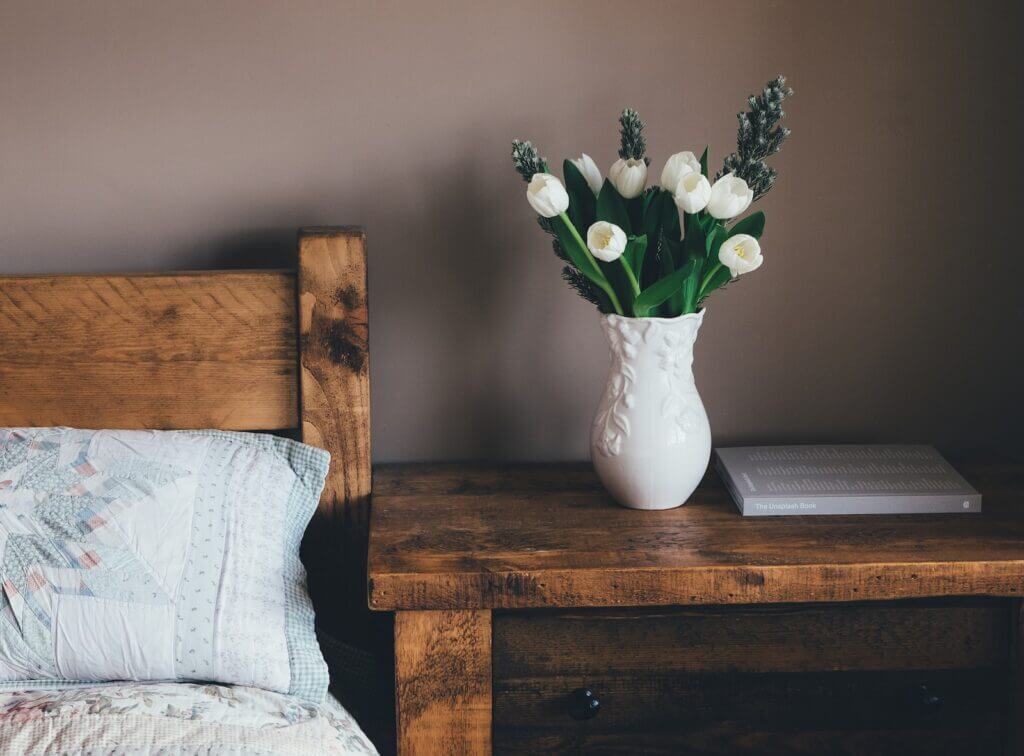Selecting the ideal bedside table is about more than just style. The dimensions of your nightstand – height, width, and depth – need to suit your bedroom layout and everyday needs. The perfect nightstand provides ample surface space without crowding your bed. It gives you essential storage without becoming a cluttered catch-all.
This ultimate guide covers standard bedside table sizes, dimensions for different beds, and how to choose the right proportions for your space. With the information to balance style and function, you’ll discover the nightstand measurements that offer convenience without overwhelming your room’s proportions.
Standard Bedside Table Dimensions
Like most furniture pieces, bedside tables come in standard sizes to accommodate different bedroom needs. Here are the typical outside dimensions for nightstand height, width, and depth:
Height
- Short: 24-26 inches
- Medium: 28 inches
- Tall: 30-32 inches
Width
- Small: 12-18 inches
- Medium: 20-26 inches
- Large: 28-32 inches
Depth
- Small: 12-16 inches
- Medium 16-20 inches
- Large: 20-22 inches
Within these ranges, most manufactured nightstands will fall. Fully customized, made-to-order furniture can be created in any dimensions. But retailers stock standard sizes like 24” wide x 16” deep x 30” tall for convenience and efficient shipping.
Beds also determine typical nightstand proportions. Let’s look at coordinating bedside table sizes with different bed frames.
Bedside Tables for Different Beds
Choosing nightstands requires factoring in your bed size. You want appropriate proportions that complement each other visually and allow enough surface space.
Twin/Single Bed
- Nightstand Height: 24-28 inches
- Nightstand Width: 18-22 inches ideal
- Nightstand Depth: At least 16 inches
A small to medium sized night table suits a single/twin bed best. Low profile styles prevent overwhelming the petite bed. Shallow depths work well in tighter rooms.
Full/Double Bed
- Nightstand Height: 26-32 inches
- Nightstand Width: 20-26 inches
- Nightstand Depth: 16-20 inches
Full and queen beds allow using medium to large sized nightstands. The bed is substantial enough to anchor larger dimensions. Depth can increase to provide more surface area.
Queen Bed
- Nightstand Height: 28-32 inches
- Nightstand Width: 22-28 inches
- Nightstand Depth: 18-22 inches
With more bed real estate, queen platforms accommodate wider nightstands. taller heights keep things proportional. Increase depth for storing larger items.
King Bed
- Nightstand Height: 30-34 inches
- Nightstand Width: 26-32 inches ideal
- Nightstand Depth: 20-24 inches
Oversized nightstands suit a spacious king bed. The wide tabletops prevent looking too small next to an expansive mattress. Extra height adds presence and gravitas.
Scaling your bedside table dimensions to match your actual bed size results in an appealing, proportional look.
How to Choose the Right Bedside Table Size
Beyond tying your nightstand size to the bed, consider these factors in selecting dimensions that work for your lifestyle:
Storage Needs
How much will you store in your bedside table? Just a book and lamp? Or loads of extra linens, electronics and bedtime essentials?
If you need substantial storage, choose a table with bigger dimensions. Wider widths, taller heights, and deeper depths accommodate more belongings. Just don’t let it become too cluttered.
Those with minimal storage needs can size down for daintier proportions. You have to balance aesthetics and function.
Room Size
What is the footprint of your bedroom? Is it compact or more spacious?
Avoid oversized bulky nightstands in a small room, as they’ll crowd the space. Petite scaled-down styles open up the room.
In a large bedroom, undersized nightstands look out of place and get overwhelmed. Larger table dimensions make a statement.
Lamp or Lighting
Check that your nightstand height accommodates bedside lamps, sconces or installed lighting. Measure lighting fixtures to ensure proper clearance.
Also consider integrated power outlets if plugging in devices. Leave acomfortable reach room so cords aren’t stretched taut.
Existing Furniture Scale
Look around at the scale of your existing dressers, beds and other bedroom furniture. Choose nightstand sizes that align aesthetically.
A dainty table looks odd next to an oversized bed. Conversely, petite beds will play second fiddle to mammoth nightstands. Seek cohesive proportions.
Personal Ergonomics
Make sure your nightstand height allows easy access from a sitting up and lying down position. You don’t want to strain to reach items.
The ideal height enables you to comfortably place items on the surface or open drawers without overextending. Test out display models in furniture stores.
Tips for Choosing the Perfect Nightstand Size
Here are some extra pointers for dialing in on nightstand dimensions that function beautifully:
- Allow at least 18-24 inches of clearance around all bed sides so the room doesn’t feel cramped.
- Look for nightstands with tiered shelves or levels to double the surface space.
- In small spaces, consider wall mounted floating nightstands for a streamlined footprint.
- Opt for shallow depths if placing nightstands inside the bed frame, not outside it.
- Have styles and finishes that relate visually, even if sizes differ on each bed side.
- Don’t exceed 32 inches wide for nightstands, or they encroach too far into room.
- Use a measuring tape to map out table footprint so you can visualize the fit.
By thoughtfully considering these size factors, you can achieve a custom bedroom look with just the right nightstand proportions.
Find Your Ideal Nightstand Size Combination
Bedside tables must strike a delicate balance between offering ample usable surface area without occupying too much floorspace. Take time to analyze your room’s dimensions, storage requirements, bed size, and existing furniture scale to make informed choices.
Refer frequently to standard sizing guides to match functionality with appropriate proportions. With this ultimate guide’s tips in mind, you now have the insights to confidently choose nightstand dimensions perfectly suited to your personal needs and bedroom style.




